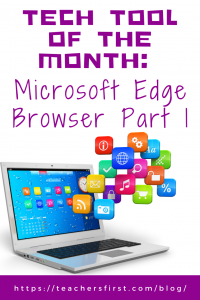Microsoft Edge is a unique browser option that contains many accessibility features, curating options, search functionalities, current events/news, and much more. Use the Immersive Reader accessibility feature to remove distracting images and “extra” stuff to make reading digital texts simpler for students. You can also use this browser’s Read Aloud feature for students who need that extra support. These options are available in countless languages, making this an ideal tool for ENL (English as a New Language) students and students studying world languages. Microsoft Edge also allows users to create collections. Learn more about Microsoft Edge and how to use these features.
Applying the Triple E Framework
The Triple E Framework, created by Dr. Liz Kolb, is built on the belief that “effective technology integration begins with good instructional strategies and not fancy tools” (tripleeframework.com). Dr. Kolb wrote a book on the topic, Learning First, Technology Second (ISTE, 2017), that lays out the three main uses for technology in education: to Engage, Enhance, or Extend learning goals. We can use this framework to decipher why we are using specific tools in the classroom. Here is a rubric based on the Triple E Framework you can use to evaluate whether Microsoft Edge (or any other technology) is a good fit with your learning goals and whether you should use it in your lesson.
- Engage in learning goals: Students are more focused on the task when using Microsoft Edge because there are no badges, games, or other extras to distract from the process of learning. The Immersive Reader option literally removes all of the “extras” to focus on just the text. Students can also work at their own pace and use the accessibility features to further engage in their learning.
- Enhance learning goals: Microsoft Edge helps students enhance their learning goals by allowing them to explore concepts, curate their own collections as they research topics, and demonstrate a more sophisticated understanding of the topic they are learning. Students use higher-order thinking skills to organize their thoughts and resources as they curate content.
- Extend learning goals: Dr. Kolb describes extended learning as an opportunity for students to learn, connect, and collaborate outside of the regular school day and as a bridge between the school day and real-life experiences. Microsoft Edge works well outside of the classroom and would fit in well with flipped, blended, and remote learning. Students can easily use Read Aloud in any location (possibly needing earbuds). They could also use the collections options to curate resources both in and out of the classroom. We are preparing our students for a world that doesn’t exist yet, but most jobs do require independent motivation and knowledge of technology. Microsoft Edge allows students to practice skills they will use in the future, as many classes and careers require students to use technology and to curate and review work-related projects and resources.
SAMR Connection
The SAMR Model, by Dr. Ruben Puentedura, suggests that technology implementation has four levels. We can use this model as a guideline to analyze how we’re using technology tools in the classroom. Tasks created with Microsoft Edge, depending on how they are used, can be at the level of Substitution, Augmentation, and Modification. Let’s talk about how we could take an activity (for example, creating a research paper) using Microsoft Edge and evolve that activity through these three levels of SAMR.
- Substitution: The level of substitution is the most basic level of SAMR and refers to when technology acts as a direct substitute without any functional improvements. An easy example of this is using Microsoft Edge to search for information for your research rather than going to a library.
- Augmentation: At the level of augmentation, the technology acts as a direct substitute but also includes some functional improvements. We could take our research paper activity with Microsoft Edge to the level of augmentation by using Immersive Reader to remove distractions (or by using the highlighting and Read Aloud features). These options would not be possible without technology that offers functional improvements.
- Modification: The level of modification allows us to make (or modify) the activity into something more integrated with technology, meaning there is significant task redesign. If we use Microsoft Edge and the Immersive Reader accessibility options to search for research to use in our paper, then use the tool to build collections of sources, we could move to the level of modification. As we search and use the accessibility features, we are also curating and collecting our own resources, offering a significant task redesign by using Microsoft Edge.
Don’t miss Part 2 of the Tech Tool of the Month: Microsoft Edge, where we’ll discuss how to use the tool and classroom use ideas by subject. In the meantime, let us know in the comment section below how you have used Microsoft Edge in your education setting.


